California Prionus in Hop
Larvae of the California prionus (Prionus californicus) can damage hop plants by feeding on their roots. This feeding results in decreased nutrient uptake by the hop plant, water stress, and reduced plant growth. Heavy Prionus infestations can cause wilting, yellowing, and the death of one or more bines or the entire plant. This pest is a major problem in Southern Idaho.
Our research team has focused on the development and field testing of pheromone traps for the California prionus. Trials to date have shown that commercial pheromone emitters may be a viable control strategy for this pest of hops.
Poster
This poster, Potential for Managing Prionus californicus in Hop Using Mating Disruption, provides a summary of research results through mid-summer 2011. Research conducted in 2010 and 2011 can be attributed to this NIFA Specialty Crops Research Initiative.
Journal Articles
Journal of Chemical Ecology, 2011, 37:114-124, Determination of the Relative and Absolute Configurations of the Female-produced Sex Pheromone of the Cerambycid Beetle Prionus californicus
Journal of Chemical Ecology, 2011, 37:714-716, Synthesis and Field Tests of Possible Minor Components of the Sex Pheromone of Prionus californicus
Journal of Economic Entomology, 2010, 103:641-647, Treating panel traps with a fluoropolymer dramatically enhances their efficiency in capturing cerambycid beetles
Commercial vs Standard Lure Study
In this study we compared the efficacy of a commercial lure with our standard lure. Commercial lures contained 15 mg of synthetic Prionus pheromone in a proprietary emitter. Standard lures consisted of clear press-seal bags that contained 15 mg of synthetic pheromone in 100 ul of hexane. Control lures were similar to standard lures but contained only hexane. Lures were tested in cross-vane panel traps placed 90 ft apart in each of 3 hop yards and treatments were randomly assigned to traps. Traps were checked and lure assignments re-randomized daily from 30 July to 20 August 2010. Captured beetles were counted and then released no closer than 90 ft from the nearest trap.
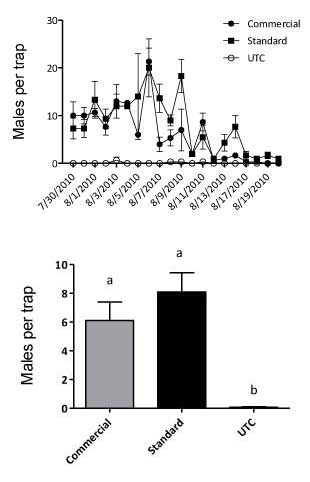 Beetle flight had begun when traps were placed. Flight peaked in early August and trap catches declined from then until traps were removed on 20 August. Although the amount of pheromone in lures was certainly declining over time, the greatest cause of the decline in capture over time was reduced beetle numbers: numbers of captured male beetles declined at this time in all Idaho hop fields in which we were conducting experiments, even when fresh lures were used. Although there were quite a few days when the commercial lures captured numerically fewer beetles than standard lures between August 7 and the end of the study, numbers did not differ significantly. The number of beetles captured by each of the lures was higher than the number captured by control lures. The top chart shows mean number of males captured by date; the second chart shows mean numbers captured overall.
Beetle flight had begun when traps were placed. Flight peaked in early August and trap catches declined from then until traps were removed on 20 August. Although the amount of pheromone in lures was certainly declining over time, the greatest cause of the decline in capture over time was reduced beetle numbers: numbers of captured male beetles declined at this time in all Idaho hop fields in which we were conducting experiments, even when fresh lures were used. Although there were quite a few days when the commercial lures captured numerically fewer beetles than standard lures between August 7 and the end of the study, numbers did not differ significantly. The number of beetles captured by each of the lures was higher than the number captured by control lures. The top chart shows mean number of males captured by date; the second chart shows mean numbers captured overall.
Mating Disruption Study with Commercial Lures
Mating disruption was tested in large (≥ 1 acre) plots using a commercial lure formulation. Experiments were conducted from 23 July to 20 August 2010 in commercial hop yards in Canyon Co, Idaho, in two replicates of four treatments each for a total of 8 plots. Plots were defined as a 6-pole by 8-pole array: 48 poles per plot. Treatments consisted of different numbers of 50 mg P. californicus pheromone emitters per pole in each plot:
- 150 mg pheromone (3 emitters) per pole
- 100 mg pheromone (2 emitters) per pole
- 50 mg pheromone (1 emitter) per pole
- 0 mg pheromone (control, 1 blank emitter) per pole
Ten traps containing surrogate females were placed in the center of each plot. A surrogate female is a low-dose pheromone lure (0.1 mg in a press-seal bag). The 0.1 mg lures are likely to be more attractive than an actual female, but we reasoned this would give a conservative estimate of mating disruption potential. We sampled these ten traps twice weekly in each plot. Lures were replaced weekly. The hypothesis was that the better the emitters worked, the fewer beetles would be captured in traps containing surrogate females in plots with treated lures: i.e. we should catch more beetles in surrogate female traps from control than from treated plots.
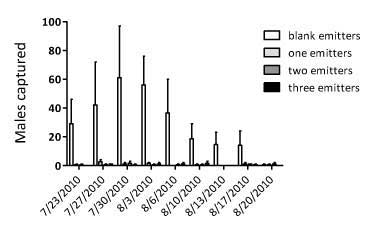 The number of males captured by surrogate female traps increased from 23 to 30 July then decreased to 20 August, when the test was halted. This decrease represents the natural decline in the beetle population in August and was not due to decreasing pheromone concentration since surrogate female lures were replaced weekly. Traps containing surrogate females captured significantly (F(3, 32)=28.52, p= 0.0105) more male beetles when surrounded by control emitters than when surrounded by emitters containing pheromone. There was no difference in the capture of males in fields containing 1, 2, or 3 treated emitters. The number of beetles captured in surrogate female traps surrounded by control emitters (544) was about 93% of the total number beetles captured by surrogate female traps surrounded by control and treated emitters (582). These data support similar, small-plot experiments conducted in 2009 and suggest that use of the synthetic P. calicornicus pheromone for mating disruption may be a viable management option for this beetle in hop. Questions regarding the optimum pheromone concentration and density of lures/emitters remain. However, given these results where there were no differences in the number of males captured by surrogate female traps surrounded by emitters containing 50 mg, 100 mg, or 150 mg of synthetic pheromone, reductions in pheromone amount or emitter density may be possible.
The number of males captured by surrogate female traps increased from 23 to 30 July then decreased to 20 August, when the test was halted. This decrease represents the natural decline in the beetle population in August and was not due to decreasing pheromone concentration since surrogate female lures were replaced weekly. Traps containing surrogate females captured significantly (F(3, 32)=28.52, p= 0.0105) more male beetles when surrounded by control emitters than when surrounded by emitters containing pheromone. There was no difference in the capture of males in fields containing 1, 2, or 3 treated emitters. The number of beetles captured in surrogate female traps surrounded by control emitters (544) was about 93% of the total number beetles captured by surrogate female traps surrounded by control and treated emitters (582). These data support similar, small-plot experiments conducted in 2009 and suggest that use of the synthetic P. calicornicus pheromone for mating disruption may be a viable management option for this beetle in hop. Questions regarding the optimum pheromone concentration and density of lures/emitters remain. However, given these results where there were no differences in the number of males captured by surrogate female traps surrounded by emitters containing 50 mg, 100 mg, or 150 mg of synthetic pheromone, reductions in pheromone amount or emitter density may be possible.
Evaluation of Coating in Panel Traps
We evaluated the impact of Fluon© fluoropolymer trap coating as an aid in capturing beetles in pheromone-baited panel traps.
Using pheromone to mass trap male beetles may be a viable strategy for managing P. californicus in hop. In that event, panel traps (i.e. cross vane or interceptor traps) may be preferable to the pitfall traps used in much of the current pheromone research. Pitfall traps must be buried between hop rows, where they can interfere with field operations. Because they must be buried flush with the soil level to be effective, they are difficult to install, maintain and move. Panel trap placement is more flexible: they can be placed in hop rows (where they are less likely to interfere with field operations), can be easily moved, and are easier to maintain because they are above ground. However, the efficiency at which panel traps capture some small cerambycid beetles is low because beetles are able to land on and walk on trap surfaces and subsequently fly way, avoiding capture. Coating panel trap surfaces with Fluon prevents beetle escape by rendering trap surfaces more slippery, preventing beetles from walking on and subsequently escaping from traps (see 2010 Journal of Economic Entomology article). It was unclear whether coating panel trap surfaces with Fluon© would aid in the capture of larger cerambycid species such as P. californicus.
We tested the hypothesis that Fluon would increase capture of male P. californicus by comparing the capture of males in Fluon-treated and untreated traps in hop yards. There were three treatments, a Fluon-coated trap baited with a 1 mg pheromone lure, a Fluon-coated traps baited with a control lure, and an uncoated trap baited with a 1 mg pheromone lure. Traps were set up 90 ft. apart between rows of hops in each of three hop yards. The experiment was repeated on eight consecutive evenings between 9 July-16 July 2010, with treatment combinations re-randomized each day in each of the three fields. Males that were captured in the traps were counted each morning and released into vegetation at least 18 m from the nearest trap.
The mean number of males captured was significantly affected by treatment. Fluon-coated traps baited with control lures captured fewer males than Fluon-coated traps and uncoated traps containing pheromone treated lures. There was no difference in the number of beetles captured by Fluon-coated and uncoated traps baited with pheromone lures. Although numbers of beetles captured was low, these results indicate that coating traps with Fluon did not increase the number of beetles captured, and would not be necessary in a mass trapping program for P. californicus.
Fluon Treatment |
Pheromone Treatment |
Males Captured |
Student’s t (p ≤0.05) |
Fluon |
1 mg |
0.96 ± 0.19 |
A |
Fluon |
none |
0.04 ± 0.04 |
B |
None |
1 mg |
1.33 ± 0.26 |
A |
Entomology subpage
This page is designed to provide additional information pursuant to the Entomology component of the overall project discussed on the Washington State University website http://hopmintstress.wsu.edu .
It is not designed to be viewed or utilized independently of that website.
Return to Entomology page.
Return to home page.
Journal Articles

Articles in the Journal of Chemical Ecology:
Determination of Prionus pheromone
Synthesis and field tests of Prionus pheromone
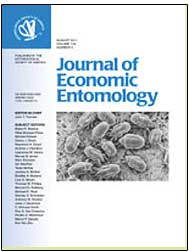
Article in the Journal of Economic Entomology
Increasing efficiency of panel traps
California Prionus Images
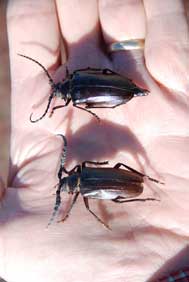
Adult female and male
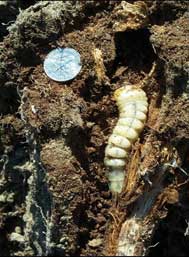
Larva
Bait and Trap Images

Pheromone-baited pitfall trap
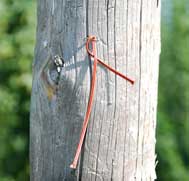
Pacific BioControl pheromone dispenser on hop pole
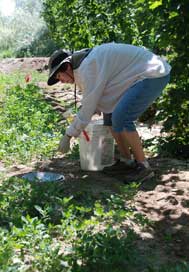
Checking pheromone-baited pitfall trap in hop row
![Male Prionus caught in pitfall trap]](images/Male-P-californicus-caught-at-pheromone-trapOPT.jpg)
Male Prionus caught in pitfall trap